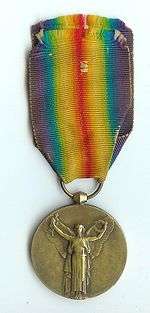1914–1918 Inter-Allied Victory medal (France)
| 1914–1918 Inter-Allied Victory medal (France) | |
|---|---|
|
Obverse and reverse of the 1914–1918 Inter-Allied Victory medal | |
|
Awarded by | |
| Type | Commemorative Medal |
| Eligibility | Allied military forces, and attached civilians |
| Awarded for | Participation in World War I |
| Status | No longer awarded |
| Statistics | |
| Established | 20 July 1922 |
| Precedence | |
| Next (higher) | Médaille commémorative du Maroc (1909) |
| Next (lower) | Médaille commémorative de la bataille de Verdun |
| Related | Médaille commémorative de la guerre 1914–1918 |
|
Ribbon of the 1914–1918 Inter-Allied Victory medal | |
The 1914–1918 Inter-Allied Victory medal (French: "Médaille Interalliée de la Victoire 1914–1918") was a French commemorative medal established 20 July 1922. It was awarded to all soldiers who served three months, consecutive or not, between 2 August 1914 and 11 November 1918 in the war zone. It was also awarded to civilian nurses, aliens (civilian or military) who served directly under French command, Marshals and generals who had a command for at least three months, prisoners of war from Alsace and Lorraine (region). Article 10 of the establishing law states: "The award of the medal is also acquired by military members who were killed by the enemy or died from wounds of war and those (....) who died of disease or injury incurred in service."[1]
International award
France, as well as a significant number of Allies and associated countries involved in the conflict against the Central Powers issued a Victory Medal. The proposal for such a common award was first made by French Marshal Ferdinand Foch who was supreme commander of the Allied Forces during the First World War. Each medal, in bronze, has the same diameter (36 mm) and ribbon (double rainbow), but with a national design representing a winged Victory. In countries where an allegorical winged victory did not make cultural sense, another design theme was utilized.
| Country | Designer | Manufacturer | Number issued |
|---|---|---|---|
| Belgium | Paul Du Bois (1859–1938) | ----- | 300,000 – 350,000 |
| Brazil | Jorge Soubre (1890–1934) |
|
approximately 2,500 |
| Cuba | Charles Charles |
|
6,000 – 7,000 |
| Czechoslovakia | Otakar Španiel (1881–1955) |
|
approximately 89,500 |
| France | Pierre-Alexandre Morlon (1878–1951) |
|
approximately 2,000,000 |
| France[2] | Charles Charles |
|
----- |
| France[2] |
|
----- | ----- |
| Great Britain[3] | William McMillan (1887–1977) |
|
6,334,522 plus |
| Greece | Henry-Eugène Nocq (1868–1944) |
|
approximately 200,000 |
| Italy | Gaetano Orsolini (1884–1954) |
|
approximately 2,000,000 |
| Japan[4] | Shoukichi Hata |
|
approximately 700,000 |
| Poland[5] | .... Vlaitov |
|
----- |
| Portugal | João Da Silva (1880–1960) |
|
approximately 100,000 |
| Rumania | .... Kristesko | ----- | approximately 300,000 |
| Siam (Thailand) | Itthithepsan Kritakara (1890–1935) | ----- | approximately 1,500 |
| South Africa[6] | William McMillan (1887–1977) |
|
approximately 75,000 |
| United States | James Earle Fraser (1876–1953) |
|
approximately 2,500,000 |
(Main source : ‘’The interallied victory medals of world war I’’ by Alexander J. Laslo, Dorado Publishing, Albuquerque. 1986 Edition )
Attestation paper
An attestation paper was given to each receiper allowing him to wear the medal.

See also
References
- ↑ Champenois, Marc (1 January 2011), "MÉDAILLE INTERALLIÉE dite MÉDAILLE DE LA VICTOIRE", France-phaleristique.com (in French), retrieved 6 June 2011
- 1 2 Unofficial type.
- ↑ Awarded not only to British combatants but as well to those from the dominions of Canada, Australia, New Zealand and those from the Empire of India.
- ↑ On the obverse the winged figure of Victory was replaced by a warrior holding a spear.
- ↑ For reasons still not known, Poland did not proceed with the manufacture of the medal at their mint. The medal shows a clearly visible “MK” ( Mint Kremnica). The medal may possibly be an unofficial strike by a veteran’s group.
- ↑ The text on the reverse is in English and Dutch.

